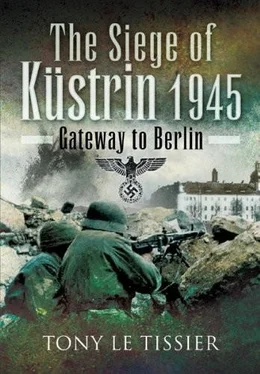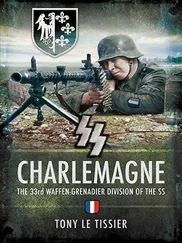Tony Le Tissier - Siege of Küstrin, 1945
Здесь есть возможность читать онлайн «Tony Le Tissier - Siege of Küstrin, 1945» весь текст электронной книги совершенно бесплатно (целиком полную версию без сокращений). В некоторых случаях можно слушать аудио, скачать через торрент в формате fb2 и присутствует краткое содержание. Город: Barnsley, Год выпуска: 2009, ISBN: 2009, Издательство: Pen & Sword Military, Жанр: military_history, на английском языке. Описание произведения, (предисловие) а так же отзывы посетителей доступны на портале библиотеки ЛибКат.
- Название:Siege of Küstrin, 1945
- Автор:
- Издательство:Pen & Sword Military
- Жанр:
- Год:2009
- Город:Barnsley
- ISBN:978-1-848-84716-3
- Рейтинг книги:4 / 5. Голосов: 1
-
Избранное:Добавить в избранное
- Отзывы:
-
Ваша оценка:
- 80
- 1
- 2
- 3
- 4
- 5
Siege of Küstrin, 1945: краткое содержание, описание и аннотация
Предлагаем к чтению аннотацию, описание, краткое содержание или предисловие (зависит от того, что написал сам автор книги «Siege of Küstrin, 1945»). Если вы не нашли необходимую информацию о книге — напишите в комментариях, мы постараемся отыскать её.
Siege of Küstrin, 1945 — читать онлайн бесплатно полную книгу (весь текст) целиком
Ниже представлен текст книги, разбитый по страницам. Система сохранения места последней прочитанной страницы, позволяет с удобством читать онлайн бесплатно книгу «Siege of Küstrin, 1945», без необходимости каждый раз заново искать на чём Вы остановились. Поставьте закладку, и сможете в любой момент перейти на страницу, на которой закончили чтение.
Интервал:
Закладка:
The general feeling among the officers and men was that they fully understood that the fortress had to be held until the last minute, but they did not see why the order should not be given to break through to the German lines when the ammunition ran out and so save at least some of the troops. It was known that the ammunition would run out within a few hours and, if there were no further orders, about 1,500 men would have to wait until the Bolsheviks came and slaughtered them. I believe there were also officers who were determined to risk a breakout with their men should no order come from the local command for a combined one. All, however, were determined only to leave the fortress at the very last moment. It seemed senseless to fire their last round in Küstrin and then await the arrival of the Bolsheviks unarmed. Once it was established that no help could be expected from outside, one often heard that soldiers and even officers were proposing to the local command that they should now act independently. As no such orders came, even more rumours circulated among the troops that the fortress commander was no longer with them and they were leaderless. Encountering such rumours did not help much. When a leader is present he has to deal with this situation himself. The fortress commandant could only deal with it in one way, which was to order a combined breakout by the rest of the men. There was no alternative, for the prerequisite for the defence of the fortress was ammunition, and that was lacking.
At about 0800 hours on the 27th March the Russians started a three-hour bombardment that also covered Kuhbrücken-Vorstadt. Behind it they began an attack from Neu Bleyen and the west. As the Soviet infantry attacked, the German infantry turned and ran. Brandishing a drawn pistol, several officers tried to get their men back into their positions, but it did not work. Some of the foxholes were abandoned by the troops at the main Soviet point of attack. I saw a second lieutenant firing an automatic rifle, and a sergeant with a sub-machine gun, who used it extensively. Then there were about six Volkssturm men, who remained staunch and fired away. A Volkssturm battalion commander set an excellent example by remaining in front with these few men and telling them not to weaken. This Volkssturm officer was from the Warthegau and not known to me. I joined these men with my Party comrades from the district staff at the critical point of attack. We lay down with them and fired away continuously. This small fighting band forced the Bolsheviks to take cover and then, as we began to attack, to withdraw. Meanwhile an SS officer had got some of the men back on their feet and some 10 to 15 of them joined us in our position. More and more soldiers gradually joined us. The Russians attacked several times this day but were always beaten back. The German soldiers avoided fighting with the Russians as they were aware of their superiority in weapons. Soon every second Russian had an automatic rifle or grenade-launcher, the others having quick-firing rifles with 15 to 20 rounds. Behind the Russians were other heavy weapons. In contrast the German soldier had his old-fashioned rifle that had to be reloaded for every shot. As the ammunition in the last weeks had no more than five rounds in a clip, each bullet had to be loaded into the breach individually. During this attack German artillery was called on. They fired from the area of Tucheband, but fired too short into our own lines. After this attack also failed, the Russians used loudspeaker propaganda. They played German marches and the proclamations of German generals in Soviet captivity, always asking the German soldiers to give up the fight. The Russians used this loudspeaker propaganda on the Küstrin fronts every day. The speakers mentioned local events, which had a big effect on the troops. They mentioned the fortress commandant, other officers and also Küstrin officials by name, saying, for example, that I had gone away again or that I felt very comfortable in my home in the Neustadt.
We remained on alert day and night, for a new attack could begin any moment. On the 28th March there was a repeat performance of the day before. The concentration was on that part of the town between the Oder and the Oder-Vorflut Canal. Again we endured hour-long artillery bombardments, aerial bombing and phosphor canisters. As I had to stay in the trenches with my men, I sent my liaison officer to the Gruppenführer with my opinion once more. My question as to how much longer the ammunition would last received a chilling reply: the ammunition for the heavy weapons was all but exhausted and there was only 20 minutes’ worth of small-arms ammunition left. The Gruppenführer had assembled his officers for a conference. All the officers were unanimous in their opinion that to fire off the remaining ammunition in 20 minutes and then leave 1,500 men quite helpless was clearly senseless. All agreed that it would be better to try to use these men in the new front near Golzow. The Gruppenführer would send a telegram to the Reichsführer informing him that he had defended the fortress to the last round. My liaison officer, SS-Captain Siedke, returned at about 2200 hours with the information that the Gruppenführer had decided with a heavy heart to break through to Golzow with the remaining men. He had fulfilled his task. Now the last rounds were being kept for the breakthrough fighting. Forty artillery shells were then fired, and other rounds for which there were no longer any weapons were blown up. Everything that might be useful to the Russians was destroyed. Those of the wounded who could walk should join their units, the other wounded having unfortunately died in the flames or the demolitions. The word was passed that only the lightest clothing should be worn for the breakthrough and all pack items, overcoats, etc., should be left behind. The men only had light infantry weapons,i.e. rifles, sub-machine guns, pistols and hand grenades. The Gruppenführer arrived at Kuhbrücken with his men at 2300 hours. I had put a man with local knowledge at the head of the whole platoon of district staff; he knew every tree and bush in the Oderbruch. We set off in a southerly direction from Kuhbrücken under the cover of the Oder dyke towards Kietz. We had to cross the dyke between Kuhbrücken and Kietz individually. Of course, all talking and noise was strictly forbidden.
The local man did not look for a track but for particularly swampy ground and meadows where one could expect the fewest Soviet positions. Thus it was possible for about 1,200 men from Küstrin to move across without firing a shot or the Russians noticing. Once the first Russian lines were behind us, we went in a northerly direction with many diversions to the Schäferei sheep farm. Of course there were many Russian positions and other Soviet bunkers on the way. The rifle-armed Russian sentries thought that only Russian troops could be moving about and let us through unchallenged. The Soviet troops seemed to be sleeping in many of the bunkers but were killed in cold blood without a shot being fired if they drew attention to themselves. Certainly it would have been possible to take a large number of prisoners along with us, but as it remained uncertain what kind of fighting awaited us, this was not done. The troops were in a good fighting mood on this march. On one occasion I saw a solder angrily berating for five minutes a Russian who had surrendered. When the Russians realised that they were confronted by German soldiers, they usually surrendered. We were not fired on once from Russian bunkers or by sentries.
One outstanding advantage for us on this enterprise was the weather: it was a dark night and raining. The stress of the march was nevertheless immense. We stumbled mainly though swampy meadows or ploughed fields. The heavy Oder mud clung thickly to one’s boots, making walking difficult and demanding the last of one’s strength from everyone. Nearly all the men were completely exhausted, but again and again they gathered up their strength and straightened their backs. Of course we had become all mixed up and there was no longer any cohesion between companies and platoons. The constant firing of flares forced us to keep taking cover, which was physically very demanding. We came to the second Russian lines near Gorgast, where we were accosted by a Russian sentry with a password, and when we failed to reply the Russians opened up on us with two machine guns and five or six rifles. We fired back with the remainder of our ammunition, shouted ‘Hurra!’ and ran into the fire in an attack. The Russians fled when they saw that we were in earnest. The Russians then started using heavy weapons, firing shells and mortars into our ranks. This developed into a fight lasting one to one and a half hours. However, it did give us time to draw breath. Incidentally, a German soldier fired a Panzerfaust into a bunker at the beginning of the fight that silenced all the weapons in it, after which Russian soldiers immediately surrendered from two other bunkers. As our ammunition was about to run out, we suddenly stopped firing and kept quiet. We marched on. Only then and now did we have to attack with cries of ‘Hurra!’ and chase the Russians away. The Very lights coming from the German lines were useless. To my knowledge, before we set off the Gruppenführer had radioed that we were trying to break through towards Golzow with 1,200 men and requesting that, should we succeed, to make tactical use of the gap. Opposing light signals were agreed. It was later established that the radio message had not got through, which was why the corresponding light signals were lacking. We had also finally lost our direction during the previous fighting. I believe that we had moved several kilometres between the Soviet and German lines. When the completely exhausted Küstrin team finally found the right direction for Golzow, we came under extraordinarily heavy fire from the German front. We replied to the fire at first, but when we realised that it was coming from the German front line, we stopped firing. With loud shouts and singing the national anthem we eventually made ourselves noticed. I reckon, however, that we had suffered our worst casualties from the German fire. In Golzow we immediately asked that the German casualties lying in no-man’s-land should be recovered that same night. I know from SS-Gruppenführer Reinefarth that he too was lying there completely exhausted and that he was finally brought out in an armoured reconnaissance vehicle. As to the extent of our casualties, I have not been able to get any approximate figures so far. We had reckoned from the start that a good half would be left on the wayside in the breakthrough. The wounded could not be brought along, as everyone had been told in advance, for the last of one’s strength was needed.
Читать дальшеИнтервал:
Закладка:
Похожие книги на «Siege of Küstrin, 1945»
Представляем Вашему вниманию похожие книги на «Siege of Küstrin, 1945» списком для выбора. Мы отобрали схожую по названию и смыслу литературу в надежде предоставить читателям больше вариантов отыскать новые, интересные, ещё непрочитанные произведения.
Обсуждение, отзывы о книге «Siege of Küstrin, 1945» и просто собственные мнения читателей. Оставьте ваши комментарии, напишите, что Вы думаете о произведении, его смысле или главных героях. Укажите что конкретно понравилось, а что нет, и почему Вы так считаете.












